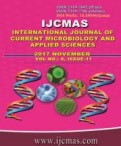


 National Academy of Agricultural Sciences (NAAS)
National Academy of Agricultural Sciences (NAAS)

|
PRINT ISSN : 2319-7692
Online ISSN : 2319-7706 Issues : 12 per year Publisher : Excellent Publishers Email : editorijcmas@gmail.com / submit@ijcmas.com Editor-in-chief: Dr.M.Prakash Index Copernicus ICV 2018: 95.39 NAAS RATING 2020: 5.38 |
An investigation as undertaken study the nature and magnitude of heterosis in ashwagandha for root yield components involving 11 germplasm 3 lines and 6 testers viz. RAS-7, RAS-15, WS-90-111, WS-90-12, WS-90-146, MSW-306, MWS-310, IGAU-1 and Poshita are selected and crosses were attempted using L x T design (Kempthorne, 1957). JA-20 and JA-134 were used as check varieties. heterosis was significant and positive for most of the characters, which revealed that its utilization in the ashwagandha breeding programme could be useful. The cross RAS-15 X WS-90-111 recorded negative heterosis over the better parent for days to 50% flowering, indicating scope for its utilization in evolving early flowering plant types. The hybrids IGAU-1 X WS-90-111, RAS-15 X MWS-310, RAS-7 X MWS-306, RAS-15 X WS-90-111 etc. showed good performance in terms of relative heterosis. The hybrids RAS-7 X MWS-306, IGAU-1 X WS-90-146, IGAU-1 X WS-90-111 etc. showed good performance in terms of better parent heterosis. The hybrids IGAU-1 X WS-90-111, IGAU-1 X WS-90-146, RAS-7 X MWS-306, RAS-7 X Poshita, RAS-15 X WS-90-146, RAS-15 X MWS-310 etc. showed good performance over both checks JA-20 and JA-134. These crosses could be exploited for obtaining high fresh root yield / plant.
 |
 |
 |
 |
 |